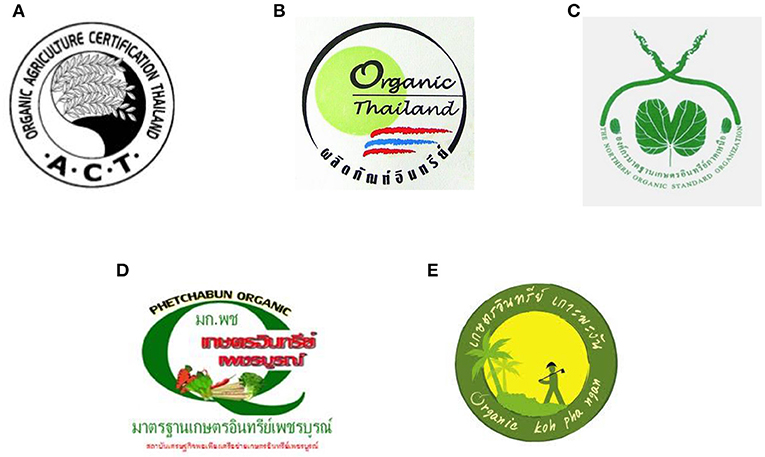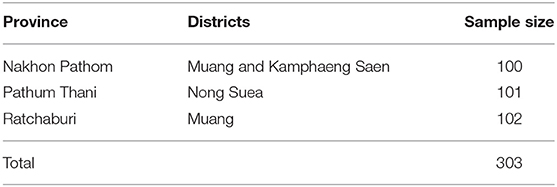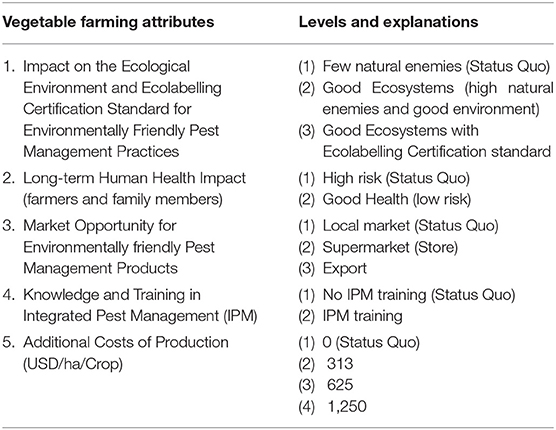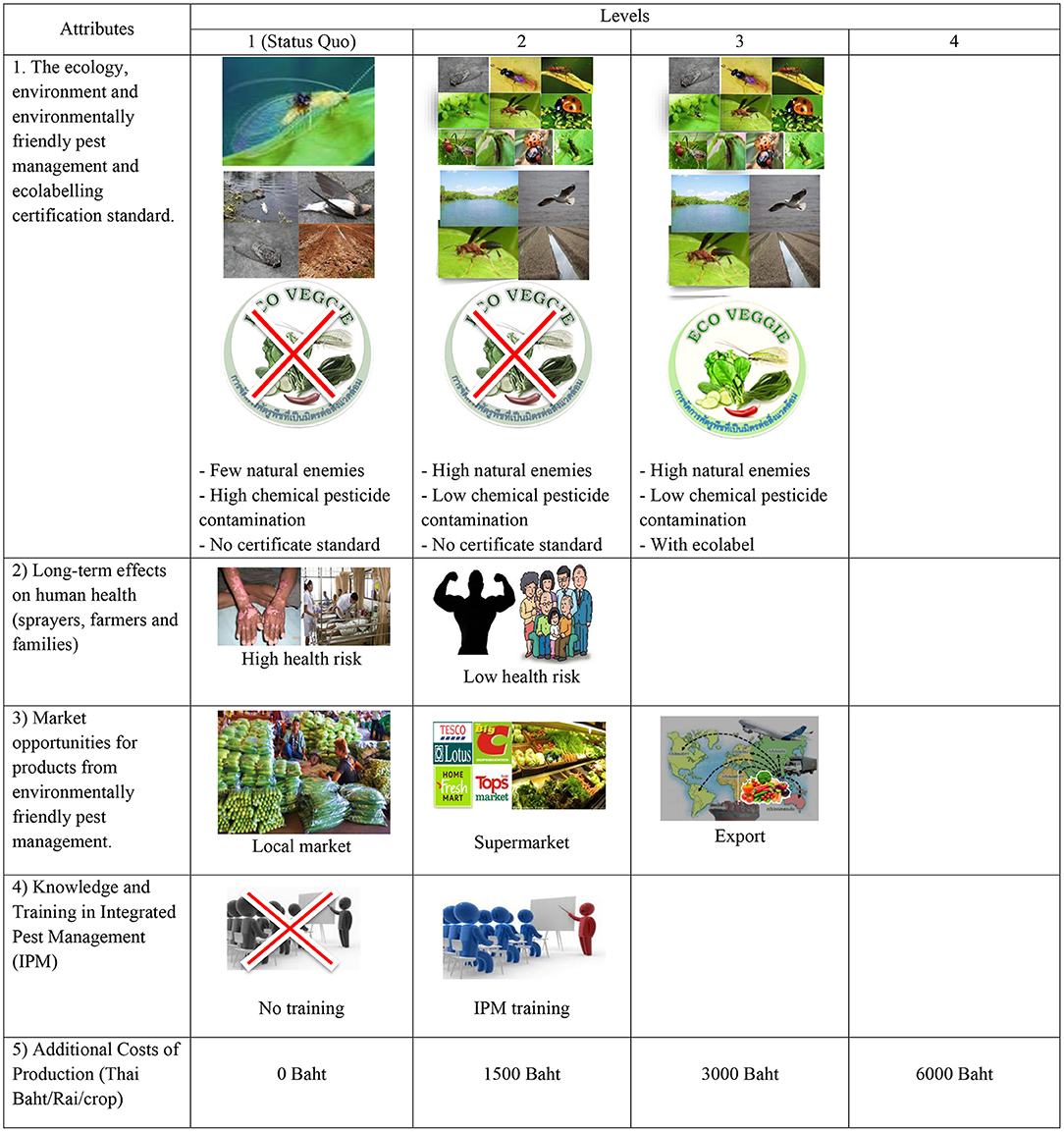- 1Department of Agricultural and Resource Economics, Faculty of Economics, Kasetsart University, Bangkok, Thailand
- 2World Vegetable Center, Bangkok, Thailand
The overuse of agricultural pesticides creates high costs to ecosystems and human health. One important reason for overuse is that markets in lower-income countries do not sufficiently differentiate agricultural produce based on quality aspects, making it difficult for consumers to select safe produce. Ecolabeling is a voluntary method of certification to gain consumer trust by differentiating produce based on environmental impact. Most studies have looked at consumer preferences for ecolabels, but the preferences of producers to adopt such labels have received much less attention. This paper aims to explore farmers' choice preference for ecolabels, safe pest management methods, human health, and the environment using a choice experiment. We sampled 303 vegetable farmers from three peri-urban provinces of Bangkok, Thailand, namely Ratchaburi, Nakhon Pathom and Pathum Thani provinces. Attributes of pest management methods and outcomes included farm ecosystems, human health, ecolabels, market opportunities, training in integrated pest management, and additional farm cost. A mixed logit model was employed to quantify the effect of each attribute on farmers' preference and marginal willingness to pay for each attribute. The data show high levels of pesticide use in vegetable production as farmers try to protect their investment from a wide range of pests and diseases. Alternative control methods are not widely available and are used in an ad-hoc manner to complement pesticides rather than substitute them. Farmers' willingness to pay for an ecolabel was 222 US$/ha/crop. However, ecolabeling had a lower priority than most other attributes. We conclude that there is a need to promote alternative pest management practices alongside ecolabels to reduce the environmental impact of vegetable farming in peri-urban areas in Thailand.
Introduction
High and incorrect use of agricultural pesticides has led to high external costs to ecosystems and human health worldwide (Konradsen et al., 2003; Carvalho, 2006). For Thailand, the external costs of pesticide use were estimated to be about USD 18.7–27.1 per hectare (ha) in 2010 (Praneetvatakul et al., 2013). Negative externalities of pesticides can be reduced by using economic incentives combined with supportive measures to change on-farm practices through awareness-raising about the adverse effects of pesticides and introducing farmers to non-chemical alternatives to manage their pest problems. The role of ecolabelling is to transfer information about the application of good agricultural practices along the value chain to consumers.
Ecolabeling is a voluntary certification approach that provides consumers with information about the environmental impact of a product based on a life cycle assessment (Global Ecolabelling Network, 2004). It allows consumers to make a better-informed decision based on their preferences regarding environmental impact, and also encourages farmers to reduce their environmental impact in order to receive a premium price for their produce (Nguyen and Le, 2020). While several previous studies have looked at consumers' willingness to pay for labeled products relative to non-labeled products, much fewer studies have looked at farmers' preferences to adopt ecolabels. Such information is important to understand if ecolabels provide a strong enough financial incentive for farmers to reduce their environmental impact.
Hence, the objective of this study is to estimate farmers' preferences and willingness to pay for certification with ecolabels. According to Altobelli et al. (2019), a higher willingness to pay (WTP) by farmers for certification may guarantee a more efficient use of resources. WTP is usually defined as the maximum amount that an individual would be willing to pay for a good or service without losing utility (Hanemann et al., 1991). Farmers' WTP may depend on many interrelated factors, such as socio-economic and demographic characteristics, individual risk preference, health, ecosystems, and knowledge. Furthermore, farmers may be more inclined to adopt certification if technical assistance is provided and they are able to command a premium price, but they may hesitate adopting certification if it increases production costs.
Several studies have identified factors influencing farmers' decision to use ecolabels. First, self-declared ecolabels (without an external certification body) were found to receive similar preferences than conventional (non-labelled) products (Delmas and Gerguad, 2021). There is therefore little incentive among farmers or consumers to adopt such labels. Second, group certification is found to increase access to certification among small and medium sized producers as compared to individual certification, although it is still not easy for marginalized producers to join (Pinto et al., 2014). Third, knowledge is critical to increase farmer awareness of the environmental benefits of a certification scheme and to stimulate farmers' motivation for and their adoption of better practices (Altobelli et al., 2019). The adoption of ecolabels by farmers requires them to make additional efforts and investment (Meemken et al., 2016), which may include administrative costs, skills upgrading, purchase of inputs, and cost of marketing.
Therefore, awareness raising about the adverse effects of pesticides and introducing farmers to safer alternatives to manage crop pests with an ecolabel can increase the adoption of agro-ecological practices, although from a very low starting point. There are also other possible benefits for farmers. Since most buyers put financial and time resources into certification, they tend to have a longer-term interest in working with a particular group of farmers (Kleemann and Abdulai, 2013), thereby investing in training to improve safety and farm performance (e.g., integrated pest management). If successfully managed, ecolabel certification for vegetable farmers in Thailand may help to increase farm incomes and reduce rural poverty by providing more stable market access and higher profits as well as attract investment, encourage governmental support, and encourage traceability. It could also benefit the local economy in the long-term.
Status of Agricultural Certification in Thailand
Organic standards in Thailand started as a result of many factors including consumer interest in food safety; concerns about the environment and ecosystems; changes in farmers' mindset on organic farming and their interest to eliminate the use of chemicals; the integration of farmers, entrepreneurs and consumers with shared ideas or interests; the proliferation of various forms of self-labeling (e.g., Nature, Bio, Green, Chemical-free); and increasing demand for organic products in foreign markets (Lohachoompol, 2018).
There are three broad types of organic certification used in Thailand: (1) third party certification systems; (2) Participatory Guarantee System (PGS); and (3) self-claims by producers or supermarkets that rely on own monitoring mechanisms.
Organic Agriculture Certification Thailand (ACT) is an example of a sustainable certificate standard used in Thailand (Figure 1A). Operators certified as ACT can use the ACT logo to sell their products (Organic Agriculture Certification Thailand, 2020). There is also “Organic Thailand” (Figure 1B), which is the official organic label of the National Bureau of Agricultural Commodity and Food Standards (ACFS). Both ACT and ACFS rely on third party certification as a verification system relying on external agencies to inspect and assure that the quality of production adheres to organic certification standards. Apart from the ACT and Organic Thailand standards, there are also other standards in use such as those of the International Federation of Organic Agriculture Movements (IFOAM), the European Union (EU), the United States Department of Agriculture (USDA). The main limitation of third-party certification is the high cost of certification, difficulties in certification when the products are diverse and produced in small quantities, and the fact that the certification system is complicated for farmers and requires many documents. As such, third party certification is often more suitable for organic products that are exported or sold in high-end stores (Lohachoompol, 2018).
Several other sustainable certificate standards in Thailand rely on PGS. These do not involve third party certification but rely on building trust between various stakeholders. Examples are the Northern Organic Standard Organization (Figure 1C), the Surin Organic Agriculture Standards Office, the Phetchabun Organic Agriculture Standards Office (Figure 1D), and the Koh Pha Ngan Organic Agriculture Association (Figure 1E), as specific standards used to certify organic products of the members of these networks. Other PGS labels include the Network of Thai Organic Agriculture Foundation (TOAF), Thai PGS Organic Plus under the Network of the Earth Net Foundation, and Lemon Farm Organic-PGS under the Network of Lemon Farms (NawaChiOne Foundation, 2021).
The use of standards is important to gain consumer confidence in agricultural products. There has been a push for the use of standards by government agencies and the private sector in accordance with IFOAM guidelines. There are also efforts to develop agricultural standards for members of particular groups, especially among development organizations such as the Northern Organic Standard Organization and the Organic Farm of Sufficiency Economy & Eco-Friendly Farming under the Royal Initiative Project in Wang Nam Keaw District, Nakhon Ratchasima Province (Green Health Fund, 2016).
Methods
Data and Study Area
Data were collected in 2016 through a survey of 303 vegetable farmers using a multi-stage stratified sampling approach. First, three provinces near Bangkok, Thailand, namely Pathum Thani, Nakhon Pathom and Ratchaburi were selected purposedly as these represent key production areas supplying vegetables to Bangkok. Ratchaburi is the province with the 2nd highest vegetable and flower planting area in the country. Ratchaburi has a total vegetable growing area of 72,685 rai.1 Pathum Thani province has a total vegetable area of 42,066 rai and Nakhon Pathom province has a total vegetable growing area of 29,114 rai (Office of Agricultural Economics., 2015). Second, the districts with the largest vegetable growing areas were selected from each province. District agricultural extension officers were visited and asked to identify villages where vegetables were produced. Next, we selected about ten vegetable farmers per selected village. A sample of 10 farmers per village was deemed sufficient as farmers in the same village often use similar production practices (Waibel, 1994). We aimed to interview about 100 farmers per province. Eventually, a total of 303 farmers were interviewed (Table 1). During the period of the survey in 2016, Kasetsart University had no requirement for an ethics approval process. Nevertheless, even if it was not independently reviewed by an ethics committee, this study did comply with general ethics such as informed consent, anonymity, and data protection.
Choice Experiment
The study employed a choice experiment to test farmers' preferences for ecolabeling their produce. Choice experiments have been widely used in the field of agri-environmental policy. For example, applications have estimated the willingness to pay to decrease pesticides toxicity to natural enemies by apple and pear growers (Gallardo and Wang, 2009), factors affecting Spanish farmers' willingness to participate in a hypothetical agri-environmental program (Espinosa-Goded et al., 2010), determinants of farmers' willingness to participate in a subsidy scheme for pesticide-free buffer zones (Christensen et al., 2011), German farmers' prospective response to the “greening” of the Common Agricultural Policy (Schulz et al., 2014), and a recent study on farmers' reluctance to reduce pesticide use (Cheze et al., 2020).
Choice experiments are a common tool to assess people's preferences or decisions in hypothetical situations, for instance, before a new product is launched, or a new technology is made available. Target groups are asked to choose their most preferred alternative from a choice set with several alternatives characterized by so-called attributes. Choice experiments involve the application of the theory of value (Lancaster, 1966) and random utility theory (McFadden, 1974), where utility refers to the total amount of satisfaction received from consuming a good or service (Louviere et al., 2000). It assumes that a good or service may be defined by a set of characteristics with the value of a good being the sum of the values of its characteristics.
A linear utility function is the most used functional form in the literature to model utility. Using such function, attributes can be treated as discrete or continuous variables and it is possible to combine qualitative and quantitative attributes in the same model. Econometric methods for analyzing choice experiments include conditional logit or mixed logit models (McFadden, 1974; Schulz et al., 2014; Cheze et al., 2020). The use of the conditional logit model has been criticized for providing unrealistic estimates because they do not represent random taste variations (Hoyos, 2010). Mixed logit models, including random parameters, are preferred to account for heterogeneous preferences in a population (Hoyos, 2010).
We asked vegetable farmers to choose their most preferred alternative from a set of choices with vegetable farming characteristics, called attributes. Our choice model was developed in four steps. First, attributes and levels were determined by experts through focus group meetings held in Bangkok and in the study areas (Table 1). Second, we calculated the number of options using a full factorial as 22 × 32 × 4 = 144 and then reduced this to 48 options using a fractional factorial design to avoid confusing respondents with too many options. Third, each choice card was built from two selected options. We used a total of 24 choice sets. Last, six patterns were produced for interviews, that is, each farmer answered four choice sets. Table 2 and Figure 2 summarize the attributes and levels used in the choice experiment. For the second attribute on the health impacts, we explained the two levels of the choice set as follows: high health risk means an adverse event or negative health consequence as a result of a risky pest management decision such as spraying toxic pesticides, while the low health risk means not being exposed to much risk as the result of a safer pest management decision such as the application of integrated pest management. The enumerators carefully explained the choice experiment cards to the interviewed farmers and provided pictures with the clear explanations. The farmers could also ask back.
A mixed logit model using a simulated maximum likelihood estimator was used to estimate the indirect utility (Vi). The model is specified as:
where:
Vi: Indirect utility of farmers;
β0: Coefficient of existing options (status quo);
βi: Coefficient of attributes;
δ: Coefficient of price;
Existing: Existing pest management;
Ecosystem: High natural enemies and good environment without ecolabel;
Ecolabel: High natural enemies and good environment but with ecolabel certificate standard;
Health: Good health (low risk to cancer due to chemical pesticide use);
Supermarket: Supermarket store;
Export: Export market;
IPM: Received training in Integrated Pest Management;
Price: Additional production costs (1,000 baht/rai/crop).
The marginal willingness to pay (MWTP) for attribute i was calculated as:
Results and Discussion
Of the sample of 303 vegetable growers, 67% were women, indicating the important contribution of women to vegetable production in peri-urban areas of Bangkok (Table 3). The average respondent was 52 years old, which is consistent with national data showing that most Thai farmers are 40–59 years old. Farm households had 2.3 members on average and had about 21 years of experience in vegetable production. The average farm was about 1.2 ha in size. Rice was the main staple crop grown, but all farm households also grew vegetables. About 39% of total farm area or 0.48 ha/farm was used to cultivate vegetables. About 33 different types of vegetables were produced in the study areas. In Nakhon Pathom province, sweet basil was the most commonly produced vegetable followed by fingerroot and Chinese kale. In Pathum Thani province, yard-long bean was the most popular vegetable followed by lemongrass and chili. In Ratchabuti province, yard-long bean, cucumber and eggplant were the most common vegetables. Most farmers sold their products to middlemen in the village.
Regarding overall pest management expenditures of the vegetable growers, it was found that vegetable farmers in Ratchaburi had the highest average cost of pest management with 3,382 baht/rai (660 USD/ha), followed by farmers in Nakhon Pathom at 2,390 baht/rai (466 USD/ha) and farmers in Pathum Thani at 1,550 baht/rai (302 USD/ha). Most farmers spent <2,000 baht/rai (390 USD/ha) (Figure 3).
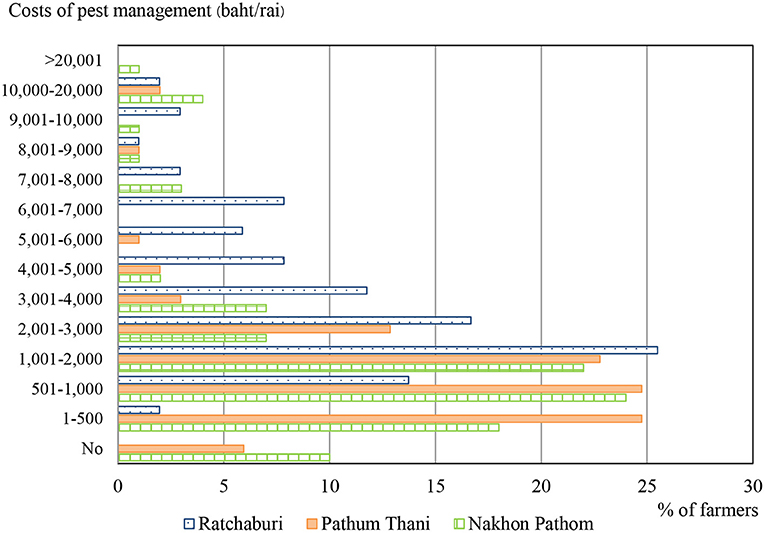
Figure 3. Cost of pest management among vegetable growers in Nakhon Pathom, Pathum Thani and Ratchaburi provinces, 2016.
The results of the choice experiment show that significant attributes included ecosystems, ecolabel certification, health, IPM training, and price (Table 4). Within the choice sets, about 10.3% of total answers selected to opt-out to the two proposed choice sets. The estimated coefficients display the expected signs for the attributes, with positive utility associated with ecosystems, ecolabel, health and IPM training, and negative utility associated with increasing cost. Ecosystems and ecolabel had a positive effect on choice, which indicates that farmers prefer to have a good ecosystem with an ecolabel to show the high quality and environmentally friendly vegetable products from their farms. In addition, certifications can inform consumers and other decision-makers about the sustainability performance of consumption choices (Curran et al., 2020). As expected, the variables “long-term health effects” and “IPM training” had a positive influence on farmers' choice. In contrast, the variables supermarket and export were not significant. This might be because most farmers prefer to sell their vegetables to the local market since there will be fewer conditions or restrictions than selling to supermarkets or export markets. However, the variable “existing pest management” is also significant implying that farmers may not be willing to accept new alternatives. Farmers may not want to adopt alternative farming practices if these increase production costs.
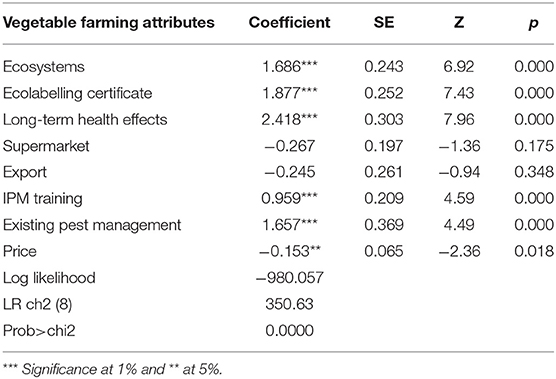
Table 4. Results of the mixed logit model for environmentally friendly vegetable farming choice options.
The parameter estimates were used to calculate the marginal WTP for the selected attributes using Equation 2. Vegetable farmers in the study area valued health as the most important aspect (3,154 USD/ha), followed by ecosystems (2,197 USD/ha), IPM training (1,274 USD/ha), and ecolabel certification (222 USD/ha) (Figure 2). These results show farmers' marginal willingness to pay for each attribute. Farmers were willing to pay 3,154 USD/ha/crop for low health risk, 2,197 USD/ha/crop for ecosystem (high natural enemies and good environment without certificate), 1,274 USD/ha/crop for knowledge and training in IPM, and 222 USD/ha/crop for an ecolabel certificate (Table 5).

Table 5. Estimates of the willingness to pay among different alternative vegetable farming attributes.
Some limitations of this study warrant attention. Health impacts were measured in qualitative terms as high and low health risk, which is not very precise. The use of quantitative data would have given a more precise estimate of WTP. Our findings suggest that the value of the quality label is tied to producer perceptions, but we did not explore variations between different labels or between different market segments, which would be valuable. The question of how the value of ecolabels varies with market channels is another topic of potential interest.
Conclusions and Recommendation
An important driver of unsustainable production practices such as pesticide overuse is that markets do not sufficiently differentiate agricultural produce based on quality aspects. Changing these practices entails additional costs and risks for farmers. Ecolabeling helps to differentiate produce based on quality aspects, which can be an important monetary incentive for farmers. Here we looked at farmers' willingness to invest in their farm to obtain ecolabels, which is an aspect that not many previous studies have looked into.
The results clearly show that vegetable farmers in peri-urban areas of Bangkok, most of whom are women, are interested to adopt certification standards for environmentally-friendly pest management practices. They prefer having a good ecosystem with lots of natural enemies, low contamination with chemical pesticides, and an ecolabel for their environmentally friendly management. Transitioning to new production practices entails cost to farmers, which necessitates higher farm-gate selling prices (Jablonski et al., 2020). Nevertheless, it might be difficult to meet producers' expectations about certification and ecolabels because of existing inefficiencies in the marketing of certified produce (Velcovasky, 2016). The success of certification with ecolabels clearly depends on the promotion of certified produce among consumers as current consumer demand for certified produce remains limited. The feasibility of ecolabeling as part of direct marketing or other market arrangements depends on consumer demand for local product attributes (Fonner, 2015). Local labels have the potential to add value to products, even in the presence of other available labels. The development of local marketing strategies will require collaboration between farmers and downstream market actors to effectively convey information about production methods, location, product handling, and other relevant information to consumers (Fonner, 2015).
The willingness of farmers to pay for the acquisition of the above attributes, as derived from the choice experiment, are used to estimate the social benefits. If environmentally friendly pest management practices would be adopted on 5% of the current vegetable growing area in Thailand then the social benefits would be about 25.3 million US$/year. This provides an indication for the size of public investments that could be made to realize these social benefits, for instance through IPM training, which is usually organized by the Department of Agricultural Extension. Christensen et al. (2011) suggested that better communication between farmers and extension services can reduce the uncertainty among farmers about the consequences of enrolling in subsidy schemes for a pesticide-free buffer zone. Investments in agricultural extension would be needed to support vegetable farmers in adopting environmentally-friendly pest management practices, which would allow to them to adopt ecolabels such as issued by the Department of Agriculture.
Our study showed that farmers have an interest in ecolabeling, but give it a lower priority than their own health or the quality of the environment. Farmers were willing to pay more for alternative pest management options to protect their own health and for achieving healthy ecosystems. Hence in promoting alternative pest management practices it will be important to also explain farmers that these practices will benefit their own health and contribute to healthy ecosystems.
We found that IPM training was important to enhance farmers' knowledge to address pesticide externalities. Ibanez and Grolleau (2008) also found that ecolabels can reduce pollution levels, but showed that ecolabeling alone is not enough to internalize all negative externalities. Therefore, to make vegetable farming in Thailand more environmentally friendly, ecolabeling needs to be promoted alongside alternative pest management practices.
Data Availability Statement
The original contributions presented in the study are included in the article/supplementary material, further inquiries can be directed to the corresponding author.
Author Contributions
SP, KV, and PS contributed to conception and design of the study. SP wrote the first draft of the manuscript. SP and PS wrote sections of the manuscript. All authors contributed to manuscript revision, read, and approved the submitted version.
Funding
We acknowledge funding received for this study from the Thailand Research Fund (TRF). This paper is a part of the project “Policy Options for Environmentally Friendly Pest Management in Thailand.”
Conflict of Interest
The authors declare that the research was conducted in the absence of any commercial or financial relationships that could be construed as a potential conflict of interest.
Publisher's Note
All claims expressed in this article are solely those of the authors and do not necessarily represent those of their affiliated organizations, or those of the publisher, the editors and the reviewers. Any product that may be evaluated in this article, or claim that may be made by its manufacturer, is not guaranteed or endorsed by the publisher.
Acknowledgments
We thank our skillful research assistants, Ms. Chaniporn Leartlam and Ms. Chonticha Janjam. We also thank the reviewers of this journal for their thoughtful comments.
Footnotes
1. ^6.25 rai = 1 hectare.
References
Altobelli, F., Monteleone, A., Cimino, O., Marta, A. D., Orlandini, S., Trestini, S., et al. (2019). Farmer's willingness to pay for an environmental certification scheme: Promising evidence for water saving. Outlook Agric. 48, 136–142. doi: 10.1177/0030727019841059
Carvalho, F. P. (2006). Agriculture, pesticides, food security and food safety. Environ. Sci. Policy 9, 685–692. doi: 10.1016/j.envsci.2006.08.002
Cheze, B., David, M., and Martinet, V. (2020). Understanding farmers' reluctance to reduce pesticide use: a choice experiment. Ecol. Econ. 167:106349. doi: 10.1016/j.ecolecon.2019.06.004
Christensen, T., Pedersen, A. B., Nielsen, H. O., Morkbak, M. R., Hasler, B., and Denver, S. (2011). Determinants of farmers' willingness to participate in subsidy schemes for pesticide-free buffer zones—a choice experiment study. Ecol. Econ. 70, 1558–1564. doi: 10.1016/j.ecolecon.2011.03.021
Curran, M., Lazzarini, G., Baumgart, L., Gabel, V., Blockeel, J., Epple, R., et al. (2020). Representative farm-based sustainability assessment of the organic sector in Switzerland using the SMART-Farm tool. Front. Sustain. Food Syst. 4:208. doi: 10.3389/fsufs.2020.554362
Delmas, M., and Gerguad, O. (2021). Sustainable practices and product quality: is there value in eco-label certification? The case of wine. Ecol. Econ. 183:106953. doi: 10.1016/j.ecolecon.2021.106953
Espinosa-Goded, M., Barreiro-Hurle, J., and Ruto, E. (2010). What do farmers want from agri-environmental scheme design? A choice experiment approach. J. Agric. Econ. 61, 259–273. doi: 10.1111/j.1477-9552.2010.00244.x
Fonner, R. (2015). Willingness to pay for multiple seafood labels in a Niche market. Mar. Resourc. Econ. 30, 51–70. doi: 10.1086/679466
Gallardo, R. K., and Wang, Q. (2009). Willingness to pay for pesticides 'environmental features and social desirability bias: the case of apple and pear growers. J. Agric. Resour. Econ. 38, 124–139. doi: 10.22004/ag.econ.148250
Global Ecolabelling Network (2004). Information Paper: Introduction to Ecolabelling. Available online at: https://globalecolabelling.net/assets/Uploads/intro-to-ecolabelling.pdf (accessed March 24, 2021).
Green Health Fund (2016). Organic Agriculture Program Under the Royal Initiative Project in Wang Nam Keaw District, Nakhon Ratchasima Province. Available online at: http://www.greenhealthfund.org/ (accessed March 3, 2021) [in Thai].
Hanemann, M., Loomis, J., and Kanninen, B. (1991). Statistical eciency of double-bounded dichotomous choice contingent valuation. Am. J. Agric. Econ. 73, 1255–1263. doi: 10.2307/1242453
Hoyos, D. (2010). The state of the art of environmental valuation with discrete choice experiments. Ecol. Econ. 69, 1595–1603. doi: 10.1016/j.ecolecon.2010.04.011
Ibanez, L., and Grolleau, G. (2008). Can ecolabeling schemes preserve the environment? Environ. Resource Econ. 40, 233–249. doi: 10.1007/s10640-007-9150-3
Jablonski, K. E., Dillon, J. A., Hale, J. W., Jablonski, B. B. R., and Carolan, M. S. (2020). One place doesn't fit all: improving the effectiveness of sustainability standards by accounting for place. Front. Sustain. Food Syst. 4:557754. doi: 10.3389/fsufs.2020.557754
Kleemann, L., and Abdulai, A. (2013). Organic certification, agro-ecological practices and return on investment: evidence from pineapple producers in Ghana. Ecol. Econ. 93, 330–341. doi: 10.1016/j.ecolecon.2013.06.017
Konradsen, F., van der Hoek, W., Cole, D. C., Hutchinson, G., Daisley, H., Singh, S., and Eddleston, M. (2003). Reducing acute poisoning in developing countries—options for restricting the availability of pesticides. Toxicology 192, 249–261. doi: 10.1016/S0300-483X(03)00339-1
Lancaster, K. J. (1966). A new approach to consumer theory. J. Political Econ. 74, 132–157. doi: 10.1086/259131
Lohachoompol, V. (2018). Guidelines for Certification of Organic Agriculture in the International System and Labeling of Organic Products. National Bureau of Agricultural Commodity and Food Standards. Available online at: http://certify.dld.go.th/certify/images/project/organic/organic2562/pwR5/2.pdf (accessed March 3, 2021) [in Thai].
Louviere, J. J., Hensher, D. A., and Swait, J. D. (2000). Stated Choice Methods: Analysis and Application. Cambridge: Cambridge University Press. doi: 10.1017/CBO9780511753831
McFadden, D. (1974). “Analysis of qualitative choice behaviour,” in Frontiers in Econometrics. (New York, NY: Academic Press).
Meemken, E. M., Veettil, P. C., and Qaim, M. (2016). Small Farmers' Preferences for the Design of Certification Schemes: Does Gender Matter?. Global Food Discussion Paper 83, University of Göttingen. Available online at: http://www.uni-goettingen.de/de/213486.html (accessed March 24, 2021).
NawaChiOne Foundation (2021). Certified Brand of Organic Products that Should be Known. Available online at: http://www.nawachione.org/ (accessed March 3, 2021) [in Thai].
Nguyen, H. T., and Le, H. T. (2020). The effect of agricultural product eco-labelling on green purchase intention. Manag. Sci. Lett. 10, 2813–2820. doi: 10.5267/j.msl.2020.4.028
Office of Agricultural Economics. (2015). Agricultural Statistics of Thailand Year 2015. Bangkok: Office of Agricultural Economics.
Organic Agriculture Certification Thailand (2020). Organic Agriculture Certification Thailand program. Available online at: http://www.actorganic-cert.or.th/en/page/item/618 (accessed October 31, 2020).
Pinto, L. F. G., Gardner, T., McDermott, C. L., and Ayub, K. O. L. (2014). Group certification supports an increase in the diversity of sustainable agriculture network–rainforest alliance certified coffee producers in Brazil. Ecol. Econ. 107, 59–64. doi: 10.1016/j.ecolecon.2014.08.006
Praneetvatakul, S., Schreinemachers, P., Pananurak, P., and Tipraqsa, P. (2013). Pesticides, external costs and policy options for Thai agriculture. Environ. Sci. Policy. 27, 103–113. doi: 10.1016/j.envsci.2012.10.019
Schulz, N., Breustedt, G., and Latacz-Lohmann, U. (2014). Assessing farmers' willingness to accept “greening”: insights from a discrete choice experiment in Germany. J. Agric. Econ. 65, 26–48. doi: 10.1111/1477-9552.12044
Velcovasky, S. (2016). Food quality labels from the producers' perspective. J. Central Eur. Agric. 17, 815–834. doi: 10.5513/JCEA01/17.3.1779
Waibel, H. (1994). “Towards and economic framework of pesticide policy studies,” in Proceedings of the Goettingen Workshop on Pesticide Policies, ed. S. Agne, G. Fleischer and H. Waibel, Goettinger Schriften zur Agraroekonomie, Vol. 66 (Goettingen: Institute of Agricultural Economics, University of Goettingen).
Keywords: certification, environment, pesticides, agriculture, peri-urban agriculture
Citation: Praneetvatakul S, Vijitsrikamol K and Schreinemachers P (2022) Ecolabeling to Improve Product Quality and Reduce Environmental Impact: A Choice Experiment With Vegetable Farmers in Thailand. Front. Sustain. Food Syst. 5:704233. doi: 10.3389/fsufs.2021.704233
Received: 02 May 2021; Accepted: 30 November 2021;
Published: 03 January 2022.
Edited by:
Pradyot Ranjan Jena, National Institute of Technology, IndiaCopyright © 2022 Praneetvatakul, Vijitsrikamol and Schreinemachers. This is an open-access article distributed under the terms of the Creative Commons Attribution License (CC BY). The use, distribution or reproduction in other forums is permitted, provided the original author(s) and the copyright owner(s) are credited and that the original publication in this journal is cited, in accordance with accepted academic practice. No use, distribution or reproduction is permitted which does not comply with these terms.
*Correspondence: Suwanna Praneetvatakul, c3V3YW5uYS5wQGt1LnRo
 Suwanna Praneetvatakul
Suwanna Praneetvatakul Kampanat Vijitsrikamol1
Kampanat Vijitsrikamol1